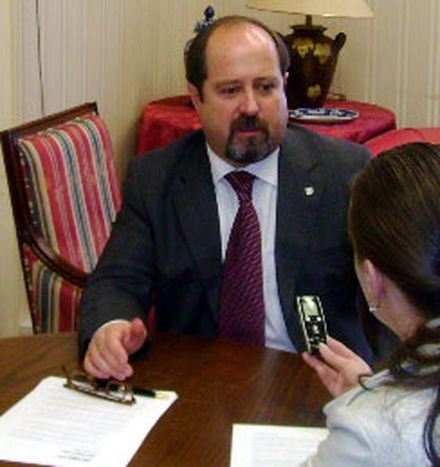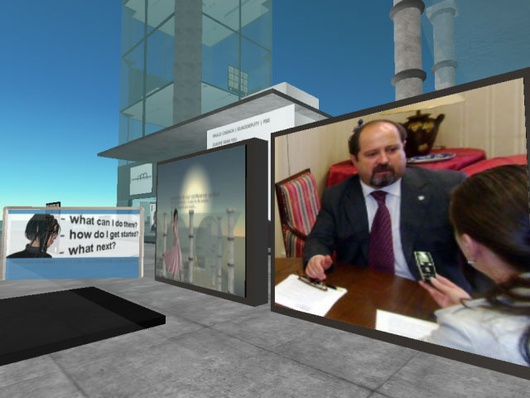
AZORES SCORE IN THE UNIVERSE…OF SPATIAL TECNOLOGIES
Published on
The Satellites Monitor Station of ESA (European Spatial Agency) in Santa Maria Island will officially open on January 17th, 2008. A small step for Europe, a huge step for Azores, that turned this project into the cradle of a policy, clearly oriented to the development of top technologies.
An idea which, in the opinion of José Contente (Regional Secretary of Housing and Equipment), has already largely contributed for Azores to be faced, not as an ultra periferical region of Europe, but as the center of the Atlantic Ocean…
CLICK HERE FOR AUDIO FILE
This project aims to monitor ATV’s (Automated Transfer Vehicle) launched in the European Center of Guiana to support the International Space Station (for example, provide goods to astronauts in orbit)? Not necessarily, even if that is, indeed the main goal. The ESA project in Santa Maria has innumerous potential usages and applies to several missions. That includes monitoring ATV’s, but also the general observation of Earth. Continuing, we can say that the Mobile Station (we already call it a permanent one, because it will remain there) has the first specific intent of monitoring, through telemetry reception, the rockets launched from the French Guiana Kourou Station. During the trajectory, a very important process (disembarkation, when the rocket parts from the launcher) happens right above Santa Maria Island. That’s why Santa Maria was chosen? Yes, it was the place ESA chose, because of the privileged location. And we are also very happy, since this is the first ESA project being developed in Portuguese territory. It was the first time that the so called “geostrategical interest” of Azores Islands has some real impact when it comes to spatial technologies subjects. What do you mean? This Station is fundamental for the birth of what it can become a “Cluster” in Regional Economy related to Spatial Technologies. There’s a path that began with this project and others are about to come. Like OceanEye, an idea from the Portuguese company EDISOFT. They will surely take advantage of the synergies created with ESA in order to build a Center of observation of the North Atlantic Ocean. On the other hand, the Azores Government, in the figure of Regional Secretary of Housing and Equipment, is in the core group of NEREUS, and an association is being created to integrate all the European regions that use spatial technology. What I’m trying to say is, we are striking to work in practical solutions that will bring, in medium term, qualified employment and of course, revenues for Azores… What measurements, in your opinion, should be taken in order to take the best out of this opportunity, in an Economic, Social and Scientific way? So it’s not just the happy marriage between a certain administration and geostrategic interest, but a solid change, with consequences and roots near the general citizens? I think this program has already contributed a great deal so that Azores are faced, not as a ultra periferic region of Europe, but like the center of the Atlantic Ocean. The positive consequences are already here…It will be a local company SEGMA, from [EDA Group] to grant all the electric maintenance of the Space Station and the workers were coached for that in ESA European centers. In a more local way, the tourist business in Santa Maria will obviously benefit from the venue of more and different visitors to the island (like the ones coming for conferences and investigation). But there is also a very global perspective and the domino effect is amazing: This OceanEye project, for instance, has a fundamental interest, both for Portugal and Azores, mainly because of the dimension of our EEZ (Exclusive Economical Zone). It’s not enough to speak about the Green Paper of the Oceans, the European Maritime Safety Agency and the responsibilities of our country when it comes to the ocean policies, just in a rhetorical way. For us, it’s fundamental that concrete facts and actions, bring political intentions into practice. Consequently, when we talk about turning Portugal to the Sea and the Hypercluster of the Ocean Economy, we must keep this in mind: only practical actions will allow us to conquer the space (in this case, not only maritime space, but space in a global way…). Finally, and also as a consequence of all of these processes, Azores Space Company is being created. It’s a concourse of EDISOFT, INSA (Aerospace Engineering and Services, Spain) and EDA, aiming to produce, in S. Miguel Island, IT Engineering Systems. This is also a great challenge for Azores University and INOVA Institute, since qualified Human Resources will be necessary… So, Azores Space is not joint company to manage the Spatial Station in Santa Maria, but a whole new project, in S. Miguel, fruit of the contacts made within Spatial Technologies field of action? Yes, exactly. Azores Space is a distinct project and has nothing to do with ESA. At this point, we have, not one, but three projects related to ST: ESA Station, OceanEye (both in Santa Maria) and Azores Space, which has already registered the name and normal legal procedures are taking place. This last Company will be installed in Lagoa Technological Park (or other public location) and will produce IT Systems…”made in Azores”. Usually, when we talk about Space, Oceans and these types of projects, we associate it to Science and Technology. However, in this case, it’s the Regional Secretary of Housing and Equipment taking supervision… The project belongs to the Azorean Regional Government and we all work for the same. However, we retain the Telecommunications competence and all these projects which are related to it. The infrastructures required to guarantee the interest of ESA in Santa Maria, for example, where mainly related to communication conditions… Even if Azores has a privileged geographic localization, the truth is Portugal is still far behind most European countries when it comes to, for example, Human Resources, a fundamental attraction factor to this type of project. Was the negotiation process complicated? What are the main problems of calling projects with this projection to Azores? The ESA project started during the government of Eng. António Guterres (Portugal Prime Minister), even if the partnership was signed only during this legislature. But Azores had an important role in all this. We had to grant ESA that all the conditions (related mainly, I repeat, to Telecommunications issues) were ensured for the success of the mobile Station… What conditions? They are inserted on what we call “Terrestrial Segment of Infrastructure”. This includes the platform where the Station was going to be installed, communications structures, electrical supplies and even the localization (that is Azorean public terrain). We did our share, so ESA understood that we were committed. In fact, when it comes to this project, all of the investments were made exclusively by ESA (in the terms of Equipment and Spatial Equipment) and the Azorean Regional Government, using our own public budget, not national resources. Those infra-structures were inaugurated in November 3rd 2005, even before the protocol signature, in November 26th of the same year, correct? Yes, that is correct. We had to invest (approximately 1 million euros) in order for the protocol to become a reality. Now, on January 17th 2008, the Station will be officially open and fully operational. The first ATV to be watched will be Jules Verne, launched by Ariene 5 and that’s predicted to happen during the first semester of 2008. Is there an official date yet? That is an ESA responsibility. Our concern was to guarantee that the Station would be fully operational from the beginning of 2008. And we are glad to say “mission accomplished”. ESA’s budget, estimated at 2904 million Euros for 2008 is supported by a quote paid for by all member States. But it also includes what is called the “geographic return”, which means that ESA will invest in each country (when it comes to partnership with companies and suppliers) more or less the same value of the paid quote. Is Santa Maria’s Station included in this “quid pro quo”? Well, Portugal contributes with something like 10 million Euros for ESA. Azores Regional Government just added one million to this budget. Naturally, aiming to insure a partnership in which we also want to be included. In the near future, Portugal and ESA will accord (and Azores wants to have an active part in that, we already sent that message to the Republic Government) when it comes to the maintenance and daily work of the Station. In our perspective, this project should continue to include Azores as a full right partner. After all, it’s a work being developed in Azores, using Azorean resources…  This is interview is also available in SECOND LIFE. PLEASE VISIT OUR PROJECT IN A.BRIDGES or contact us for more information.
This is interview is also available in SECOND LIFE. PLEASE VISIT OUR PROJECT IN A.BRIDGES or contact us for more information.



